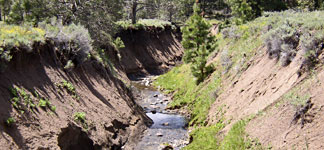|
|||||
� |
Resource Concerns >> Threatened & Endangered Species |
|||||||||
|
Threatened & Endangered Species |
|||||||||
Existing Conditions and Assessment ConclusionsThreatened and endangered species (both botanical and wildlife species) are closely linked to watershed health and function, and therefore must be treated as an integral part of the watershed management strategy. Vegetation and habitat conditions within the Pit River watershed have changed significantly over the last 150 years. These changes, which impact species composition, diversity, and density, have resulted from a variety of factors including disruption of natural fire regime, grazing, logging and agricultural practices, introduction of non-native invasive species, and modifications of stream channels and hydrology. As a result, several species within the Pit RCD area are now state or federally listed as threatened or endangered. This table includes an identification of those species, their listing status, preferred habitat, and cause for decline. In addition to the above, there are several animals identified by the State as species of special concern. Of particular concern is the Greater Sage-Grouse. Historically, numerous leks (breeding grounds) were located throughout the Pit RCD boundaries, but now only one lek is known to be active and sage grouse are rarely sited. Management StrategyA. The Pit RCD will work to preserve the rural, open space nature of the watershed which, in general, will contribute to the preservation and enhancement of T&E species. B. As described in Section D, Aquatic and Wildlife Habitat, the Pit RCD will implement projects focused on habitat protection and enhancement. Projects which have benefits for habitat used by T&E species will be given added priority. C. The Pit RCD will continue its partnership role in the Cooperative Sagebrush Steppe Restoration Initiative. Among other benefits, this project is expected to improve habitat conditions for sage grouse breeding. |
Bald eagles, a state threatened species, are abundant in northern California, and the species can be regularly observed in the area.
|
|||||||||
